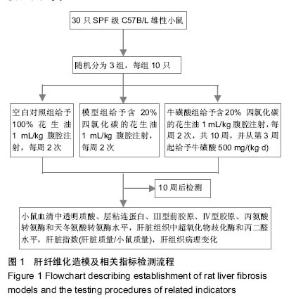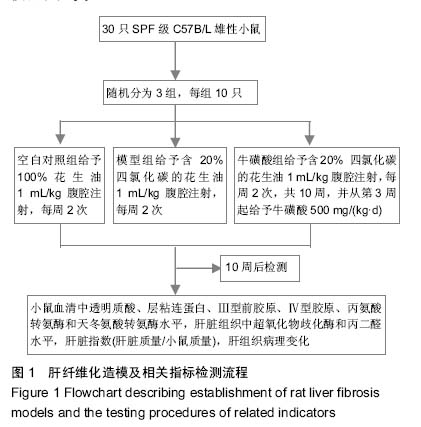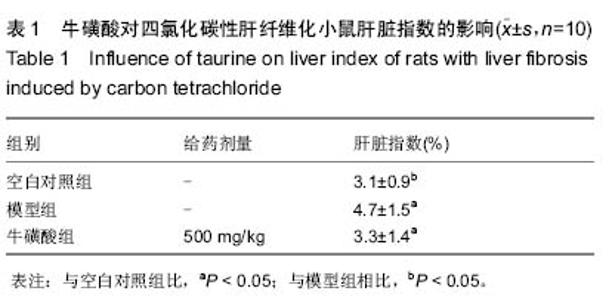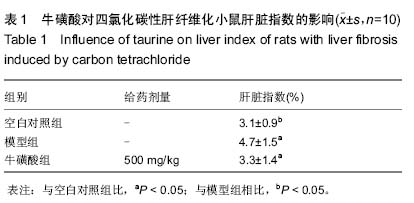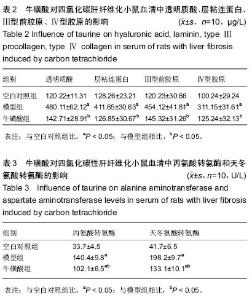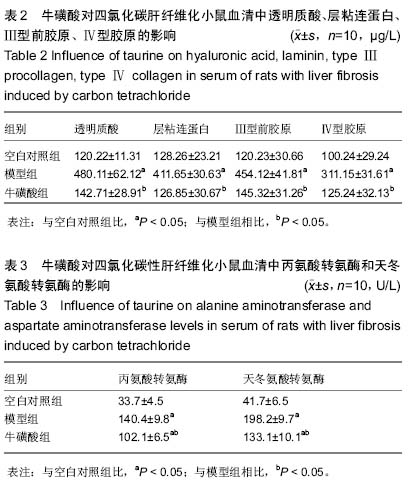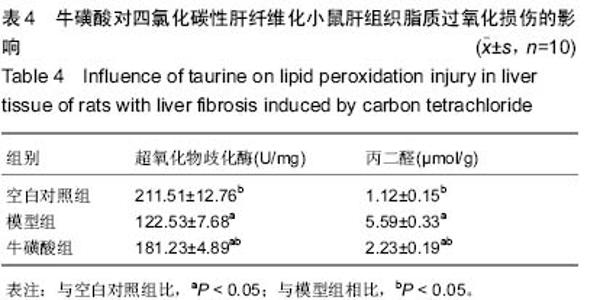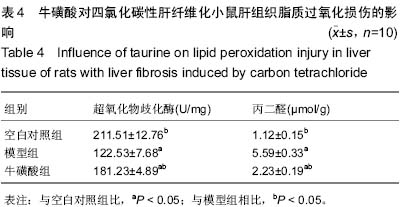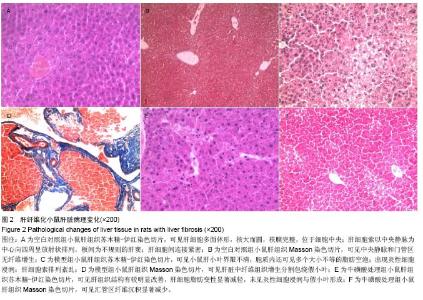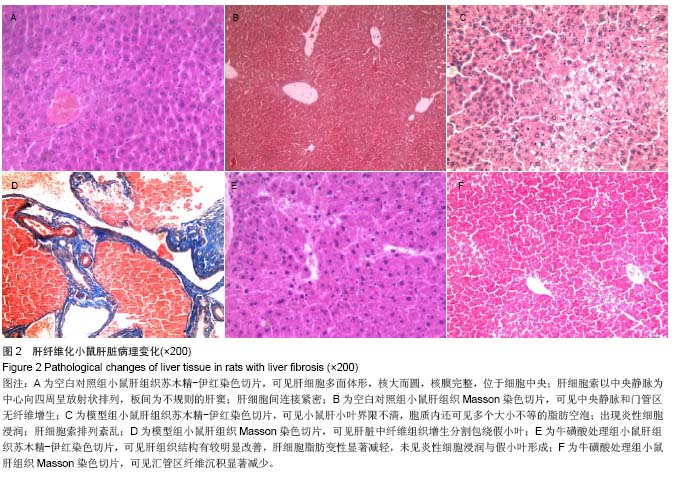| [1] 林冰,张鹏,郎锦义,等. 化纤汤防治放射性肺纤维化的实验研究[J]. 四川中医, 2015,33(4): 54-57.
[2] 王传敏,孟忠吉,柯昌征,等. GSH联合复方鳖甲软肝片治疗代偿期乙型肝炎后肝硬化的疗效分析及对肝纤维化指标和炎性因子水平的影响[J].海南医学院学报, 2015,21(5):651-653.
[3] 杨跃青,张燕,何瑾瑜,等. 化瘀疏肝汤治疗慢性乙型病毒性肝炎肝纤维化临床研究[J]. 中医学报,2015,30(5):725-727.
[4] Karaytug S, Sevgiler Y, Karayakar F. Comparison of the protective effects of antioxidant compounds in the liver and kidney of Cd- and Cr-exposed common carp. Environ Toxicol. 2014;29(2):129-137.
[5] Perumal P, Vupru K, Rajkhowa C. Effect of Addition of Taurine on the Liquid Storage (5°C) of Mithun (Bos frontalis) Semen. Vet Med Int. 2013;2013:165348.
[6] Wang GG, Li W, Lu XH, et al. Taurine attenuates oxidative stress and alleviates cardiac failure in type I diabetic rats. Croat Med J. 2013;54(2):171-179.
[7] Yu C, Mei XT, Zheng YP, et al. Gastroprotective effect of taurine zinc solid dispersions against absolute ethanol-induced gastric lesions is mediated by enhancement of antioxidant activity and endogenous PGE2 production and attenuation of NO production. Eur J Pharmacol. 2014;740:329-336.
[8] 盛婷,傅念,阳学风,等.肝纤维化发病机制中细胞和分子机制的研究进展[J].现代生物医学进展, 2015,15(12):2358-2362.
[9] Feroz Z, Khan RA, Mahayrookh A. Hepatoprotective effect of herbal drug on CCl(4) induced liver damage. Pak J Pharm Sci. 2013;26(1):99-103.
[10] Mejia-Garcia A, Sanchez-Ocampo EM, Galindo-Gomez S, et al. 2,3,7,8-Tetrachlorodibenzo-p-dioxin enhances CCl4-induced hepatotoxicity in an aryl hydrocarbon receptor-dependent manner. Xenobiotica. 2013;43(2):161-168.
[11] 刘志媛,吴高峰,徐哲,等.牛磺酸与肝脏疾病-牛磺酸多种护肝作用的重点阐述[J].现代畜牧兽医, 2013, 8(3): 60-64.
[12] Ashkani-Esfahani S, Zarifi F, Asgari Q, et al. Taurine improves the wound healing process in cutaneous leishmaniasis in mice model, based on stereological parameters. Adv Biomed Res. 2014;3:204.
[13] 张莎莎,吕文良,张旭,等.肝纤维化的治疗研究进展[J].浙江中医药大学学报, 2012, 36(4): 471-475.
[14] Maia AR, Batista TM, Victorio JA, et al. Taurine supplementation reduces blood pressure and prevents endothelial dysfunction and oxidative stress in post-weaning protein-restricted rats. PLoS One. 2014;9(8):e105851.
[15] Miao J, Zhang J, Ma Z, et al. The role of NADPH oxidase in taurine attenuation of Streptococcus uberis-induced mastitis in rats. Int Immunopharmacol. 2013;16(4):429-435.
[16] Deng Y, Wang W, Yu P, et al. Comparison of taurine, GABA, Glu, and Asp as scavengers of malondialdehyde in vitro and in vivo. Nanoscale Res Lett. 2013;8(1):190.
[17] 蔡磊,侯外林,程远,等.急性肝衰竭大鼠肝脏的蛋白质组学研究[J]. 重庆医学,2015,44(12): 1592-1595.
[18] 崔承虎,韩明子,金世柱,等.肝硬化动物模型造模方法的研究进展[J]. 现代生物医学进展,2015,15(12): 2393-1396.
[19] 付德才,吴杭源.甲珠对肝纤维化大鼠肝组织病理变化的影响[J]. 中国老年学杂志, 2014,34(21):6105-6107.
[20] 付玲珠,郑婷,张永生.TGF-β/Smad信号转导通路与肝纤维化研究进展[J]. 中国临床药理学与治疗学, 2014,19(10):1189-1195.
[21] Aghsaee M, Drakon A, Eremin A, et al. Experimental investigation and modeling of the kinetics of CCl4 pyrolysis behind reflected shock waves using high-repetition-rate time-of-flight mass spectrometry. Phys Chem Chem Phys. 2013;15(8):2821-2828.
[22] Ahmad M, Ali S, Mehmood MS, et al. Ex vivo assessment of carbon tetrachloride (CCl(4))-induced chronic injury using polarized light spectroscopy. Appl Spectrosc. 2013;67(12): 1382-1389.
[23] 梁健,邓鑫,吴发胜.牛磺酸抗肝纤维化的研究进展[J].广西医学, 2009, 31(6): 863-865.
[24] Nussler AK, Wildemann B, Freude T, et al. Chronic CCl4 intoxication causes liver and bone damage similar to the human pathology of hepatic osteodystrophy: a mouse model to analyse the liver-bone axis. Arch Toxicol. 2014;88(4):997-1006.
[25] Seo KW, Sohn SY, Bhang DH, et al. Therapeutic effects of hepatocyte growth factor-overexpressing human umbilical cord blood-derived mesenchymal stem cells on liver fibrosis in rats. Cell Biol Int. 2014;38(1):106-116.
[26] Wang J, Tang L, White J, et al. Inhibitory effect of gallic acid on CCl4-mediated liver fibrosis in mice. Cell Biochem Biophys. 2014;69(1):21-26.
[27] 吕秋凤,董公麟,曹双,等.牛磺酸抗应激作用的研究进展[J].中国畜牧杂志, 2014, 50(21): 78-81.
[28] Ma R, He S, Liang X, et al. Decorin prevents the development of CCl?-induced liver fibrosis in mice. Chin Med J (Engl). 2014; 127(6):1100-1104. |
